Leading Teams in Health and Social Care: Ellenor Hospice Team Dynamics
VerifiedAdded on 2023/01/06
|17
|5235
|96
Report
AI Summary
This report examines leadership within the health and social care sector, focusing on the case study of Ellenor, a UK-based hospice charity. The assignment analyzes the role and importance of leadership in building successful teams within the organization, highlighting the need for effective leadership to drive reforms and shape organizational culture. It explores leadership roles such as inspiring trust, creating vision, executing strategy, and coaching potential. The report also discusses the application of the T-7 Model of Team Effectiveness to build successful teams, outlining both internal and external factors that influence team performance. Furthermore, it delves into the values of theoretical models in fostering teamwork, including compassion, and the stages of team development, along with strategies for motivating team members. Finally, the report provides recommendations for open communication between leaders and team members to support team development within Ellenor.
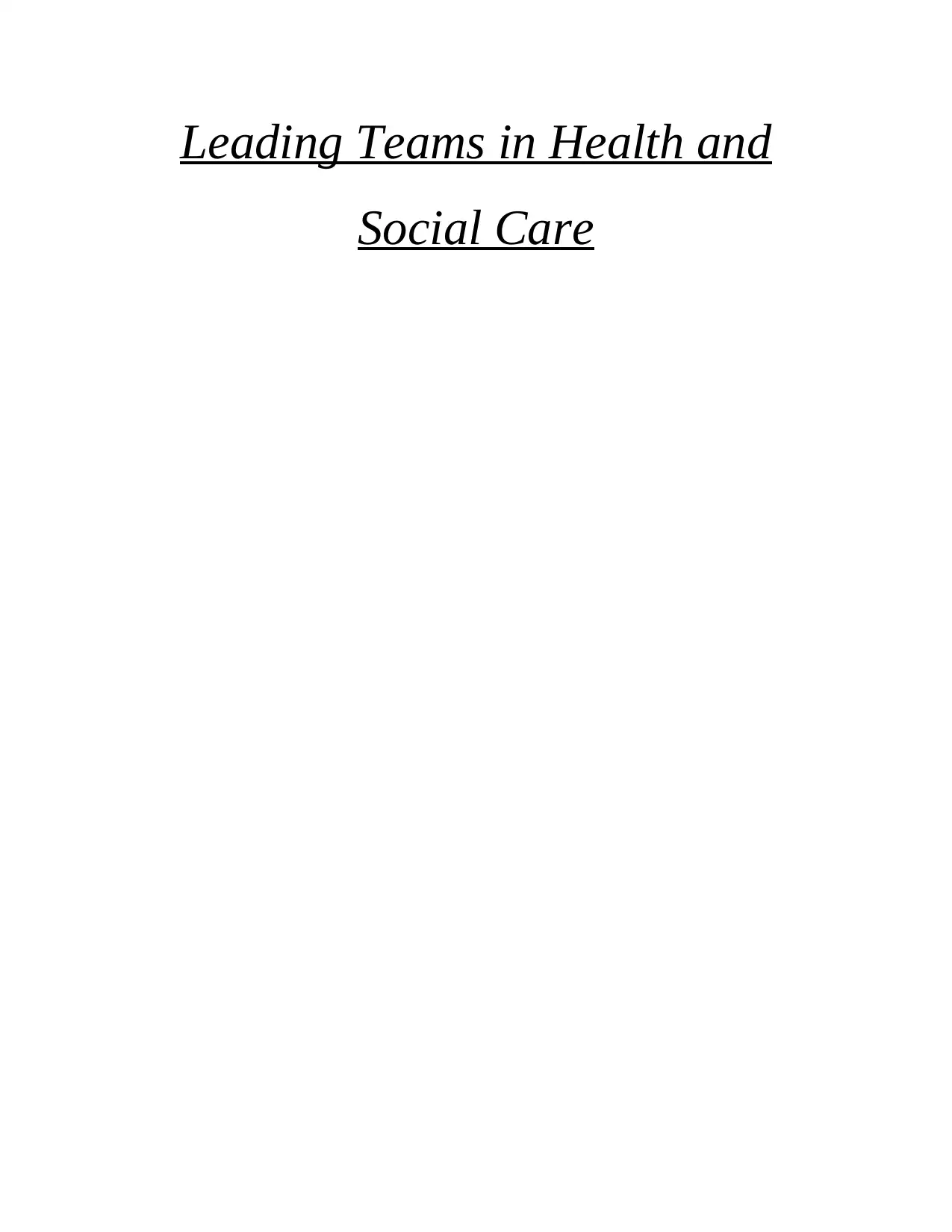
Leading Teams in Health and
Social Care
Social Care
Paraphrase This Document
Need a fresh take? Get an instant paraphrase of this document with our AI Paraphraser
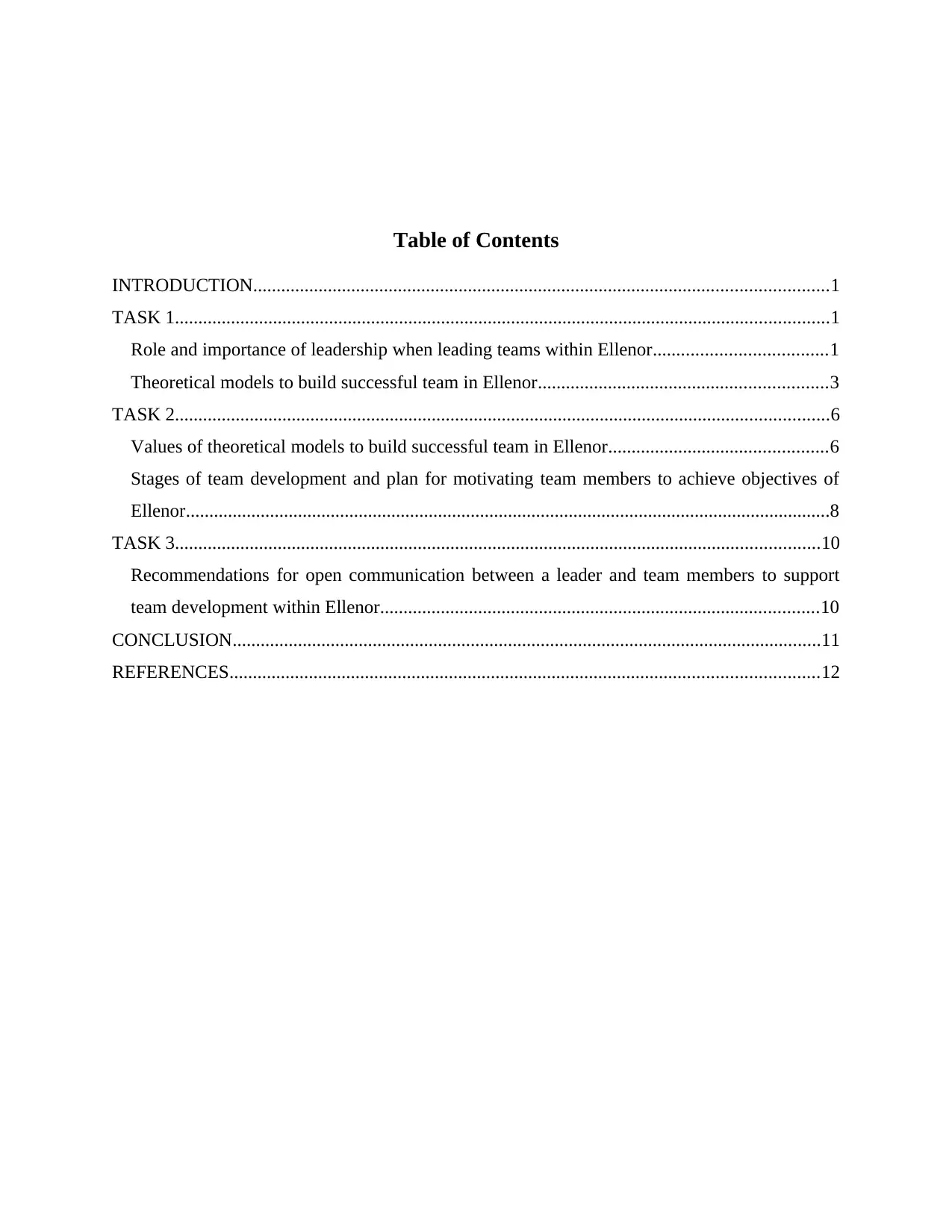
Table of Contents
INTRODUCTION...........................................................................................................................1
TASK 1............................................................................................................................................1
Role and importance of leadership when leading teams within Ellenor.....................................1
Theoretical models to build successful team in Ellenor..............................................................3
TASK 2............................................................................................................................................6
Values of theoretical models to build successful team in Ellenor...............................................6
Stages of team development and plan for motivating team members to achieve objectives of
Ellenor..........................................................................................................................................8
TASK 3..........................................................................................................................................10
Recommendations for open communication between a leader and team members to support
team development within Ellenor..............................................................................................10
CONCLUSION..............................................................................................................................11
REFERENCES..............................................................................................................................12
INTRODUCTION...........................................................................................................................1
TASK 1............................................................................................................................................1
Role and importance of leadership when leading teams within Ellenor.....................................1
Theoretical models to build successful team in Ellenor..............................................................3
TASK 2............................................................................................................................................6
Values of theoretical models to build successful team in Ellenor...............................................6
Stages of team development and plan for motivating team members to achieve objectives of
Ellenor..........................................................................................................................................8
TASK 3..........................................................................................................................................10
Recommendations for open communication between a leader and team members to support
team development within Ellenor..............................................................................................10
CONCLUSION..............................................................................................................................11
REFERENCES..............................................................................................................................12

⊘ This is a preview!⊘
Do you want full access?
Subscribe today to unlock all pages.

Trusted by 1+ million students worldwide
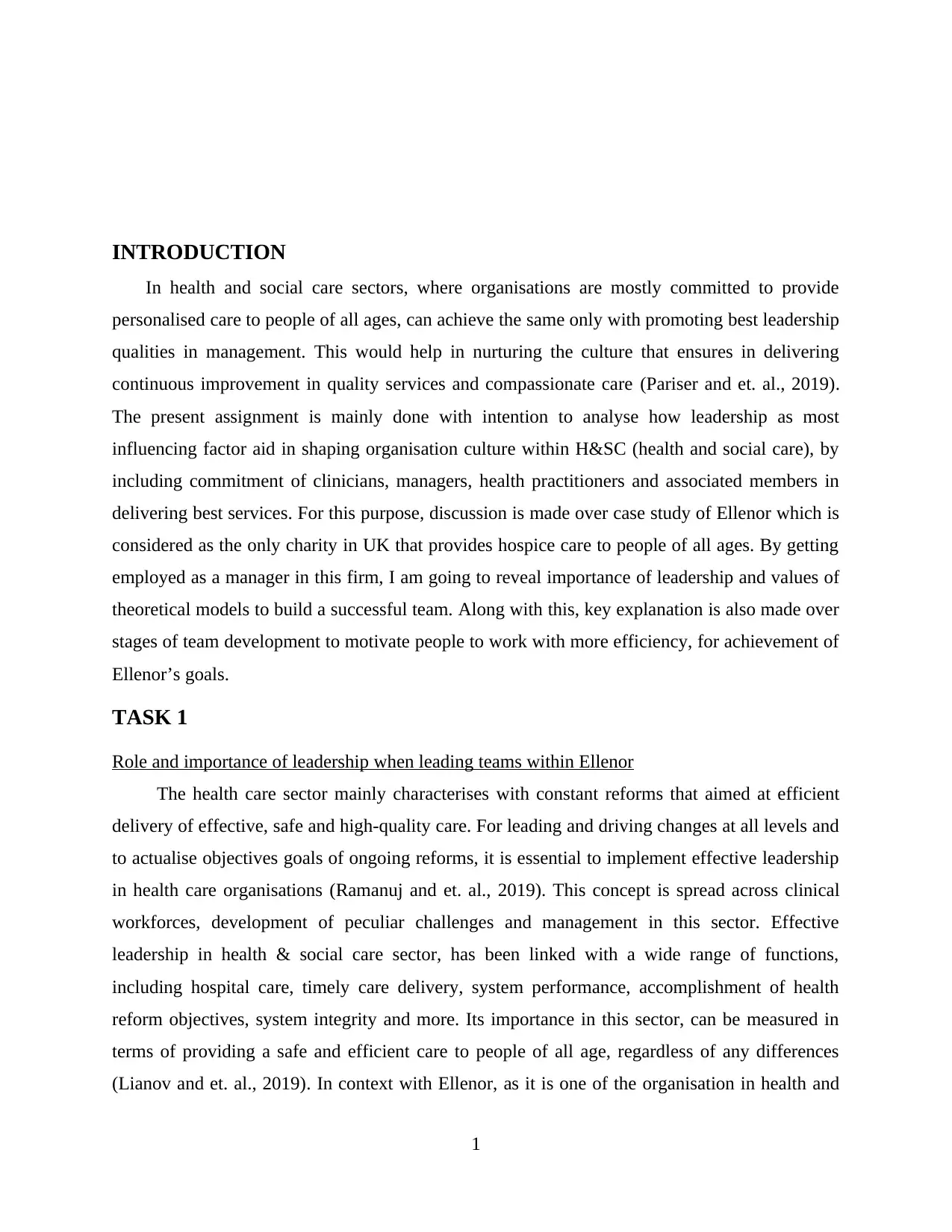
INTRODUCTION
In health and social care sectors, where organisations are mostly committed to provide
personalised care to people of all ages, can achieve the same only with promoting best leadership
qualities in management. This would help in nurturing the culture that ensures in delivering
continuous improvement in quality services and compassionate care (Pariser and et. al., 2019).
The present assignment is mainly done with intention to analyse how leadership as most
influencing factor aid in shaping organisation culture within H&SC (health and social care), by
including commitment of clinicians, managers, health practitioners and associated members in
delivering best services. For this purpose, discussion is made over case study of Ellenor which is
considered as the only charity in UK that provides hospice care to people of all ages. By getting
employed as a manager in this firm, I am going to reveal importance of leadership and values of
theoretical models to build a successful team. Along with this, key explanation is also made over
stages of team development to motivate people to work with more efficiency, for achievement of
Ellenor’s goals.
TASK 1
Role and importance of leadership when leading teams within Ellenor
The health care sector mainly characterises with constant reforms that aimed at efficient
delivery of effective, safe and high-quality care. For leading and driving changes at all levels and
to actualise objectives goals of ongoing reforms, it is essential to implement effective leadership
in health care organisations (Ramanuj and et. al., 2019). This concept is spread across clinical
workforces, development of peculiar challenges and management in this sector. Effective
leadership in health & social care sector, has been linked with a wide range of functions,
including hospital care, timely care delivery, system performance, accomplishment of health
reform objectives, system integrity and more. Its importance in this sector, can be measured in
terms of providing a safe and efficient care to people of all age, regardless of any differences
(Lianov and et. al., 2019). In context with Ellenor, as it is one of the organisation in health and
1
In health and social care sectors, where organisations are mostly committed to provide
personalised care to people of all ages, can achieve the same only with promoting best leadership
qualities in management. This would help in nurturing the culture that ensures in delivering
continuous improvement in quality services and compassionate care (Pariser and et. al., 2019).
The present assignment is mainly done with intention to analyse how leadership as most
influencing factor aid in shaping organisation culture within H&SC (health and social care), by
including commitment of clinicians, managers, health practitioners and associated members in
delivering best services. For this purpose, discussion is made over case study of Ellenor which is
considered as the only charity in UK that provides hospice care to people of all ages. By getting
employed as a manager in this firm, I am going to reveal importance of leadership and values of
theoretical models to build a successful team. Along with this, key explanation is also made over
stages of team development to motivate people to work with more efficiency, for achievement of
Ellenor’s goals.
TASK 1
Role and importance of leadership when leading teams within Ellenor
The health care sector mainly characterises with constant reforms that aimed at efficient
delivery of effective, safe and high-quality care. For leading and driving changes at all levels and
to actualise objectives goals of ongoing reforms, it is essential to implement effective leadership
in health care organisations (Ramanuj and et. al., 2019). This concept is spread across clinical
workforces, development of peculiar challenges and management in this sector. Effective
leadership in health & social care sector, has been linked with a wide range of functions,
including hospital care, timely care delivery, system performance, accomplishment of health
reform objectives, system integrity and more. Its importance in this sector, can be measured in
terms of providing a safe and efficient care to people of all age, regardless of any differences
(Lianov and et. al., 2019). In context with Ellenor, as it is one of the organisation in health and
1
Paraphrase This Document
Need a fresh take? Get an instant paraphrase of this document with our AI Paraphraser
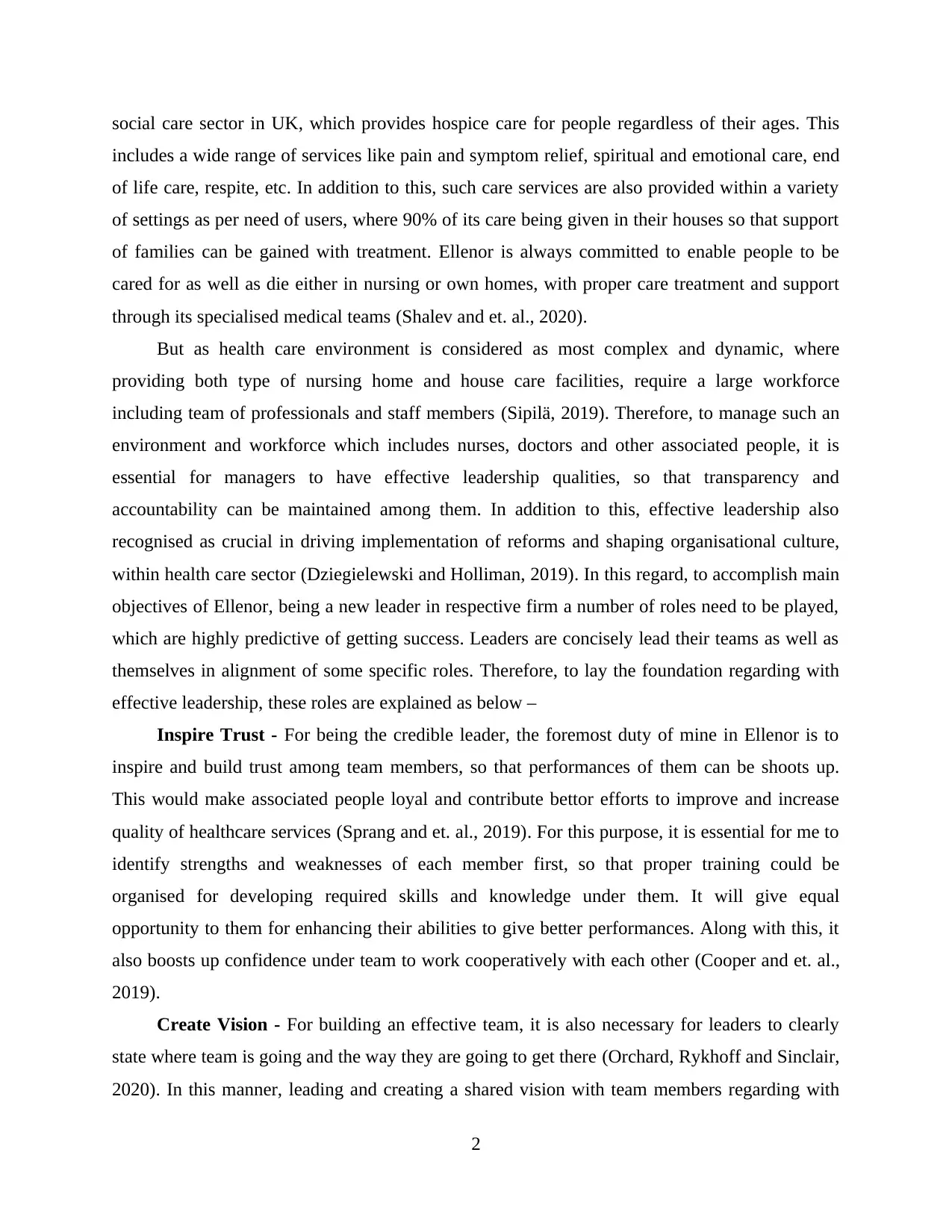
social care sector in UK, which provides hospice care for people regardless of their ages. This
includes a wide range of services like pain and symptom relief, spiritual and emotional care, end
of life care, respite, etc. In addition to this, such care services are also provided within a variety
of settings as per need of users, where 90% of its care being given in their houses so that support
of families can be gained with treatment. Ellenor is always committed to enable people to be
cared for as well as die either in nursing or own homes, with proper care treatment and support
through its specialised medical teams (Shalev and et. al., 2020).
But as health care environment is considered as most complex and dynamic, where
providing both type of nursing home and house care facilities, require a large workforce
including team of professionals and staff members (Sipilä, 2019). Therefore, to manage such an
environment and workforce which includes nurses, doctors and other associated people, it is
essential for managers to have effective leadership qualities, so that transparency and
accountability can be maintained among them. In addition to this, effective leadership also
recognised as crucial in driving implementation of reforms and shaping organisational culture,
within health care sector (Dziegielewski and Holliman, 2019). In this regard, to accomplish main
objectives of Ellenor, being a new leader in respective firm a number of roles need to be played,
which are highly predictive of getting success. Leaders are concisely lead their teams as well as
themselves in alignment of some specific roles. Therefore, to lay the foundation regarding with
effective leadership, these roles are explained as below –
Inspire Trust - For being the credible leader, the foremost duty of mine in Ellenor is to
inspire and build trust among team members, so that performances of them can be shoots up.
This would make associated people loyal and contribute bettor efforts to improve and increase
quality of healthcare services (Sprang and et. al., 2019). For this purpose, it is essential for me to
identify strengths and weaknesses of each member first, so that proper training could be
organised for developing required skills and knowledge under them. It will give equal
opportunity to them for enhancing their abilities to give better performances. Along with this, it
also boosts up confidence under team to work cooperatively with each other (Cooper and et. al.,
2019).
Create Vision - For building an effective team, it is also necessary for leaders to clearly
state where team is going and the way they are going to get there (Orchard, Rykhoff and Sinclair,
2020). In this manner, leading and creating a shared vision with team members regarding with
2
includes a wide range of services like pain and symptom relief, spiritual and emotional care, end
of life care, respite, etc. In addition to this, such care services are also provided within a variety
of settings as per need of users, where 90% of its care being given in their houses so that support
of families can be gained with treatment. Ellenor is always committed to enable people to be
cared for as well as die either in nursing or own homes, with proper care treatment and support
through its specialised medical teams (Shalev and et. al., 2020).
But as health care environment is considered as most complex and dynamic, where
providing both type of nursing home and house care facilities, require a large workforce
including team of professionals and staff members (Sipilä, 2019). Therefore, to manage such an
environment and workforce which includes nurses, doctors and other associated people, it is
essential for managers to have effective leadership qualities, so that transparency and
accountability can be maintained among them. In addition to this, effective leadership also
recognised as crucial in driving implementation of reforms and shaping organisational culture,
within health care sector (Dziegielewski and Holliman, 2019). In this regard, to accomplish main
objectives of Ellenor, being a new leader in respective firm a number of roles need to be played,
which are highly predictive of getting success. Leaders are concisely lead their teams as well as
themselves in alignment of some specific roles. Therefore, to lay the foundation regarding with
effective leadership, these roles are explained as below –
Inspire Trust - For being the credible leader, the foremost duty of mine in Ellenor is to
inspire and build trust among team members, so that performances of them can be shoots up.
This would make associated people loyal and contribute bettor efforts to improve and increase
quality of healthcare services (Sprang and et. al., 2019). For this purpose, it is essential for me to
identify strengths and weaknesses of each member first, so that proper training could be
organised for developing required skills and knowledge under them. It will give equal
opportunity to them for enhancing their abilities to give better performances. Along with this, it
also boosts up confidence under team to work cooperatively with each other (Cooper and et. al.,
2019).
Create Vision - For building an effective team, it is also necessary for leaders to clearly
state where team is going and the way they are going to get there (Orchard, Rykhoff and Sinclair,
2020). In this manner, leading and creating a shared vision with team members regarding with
2
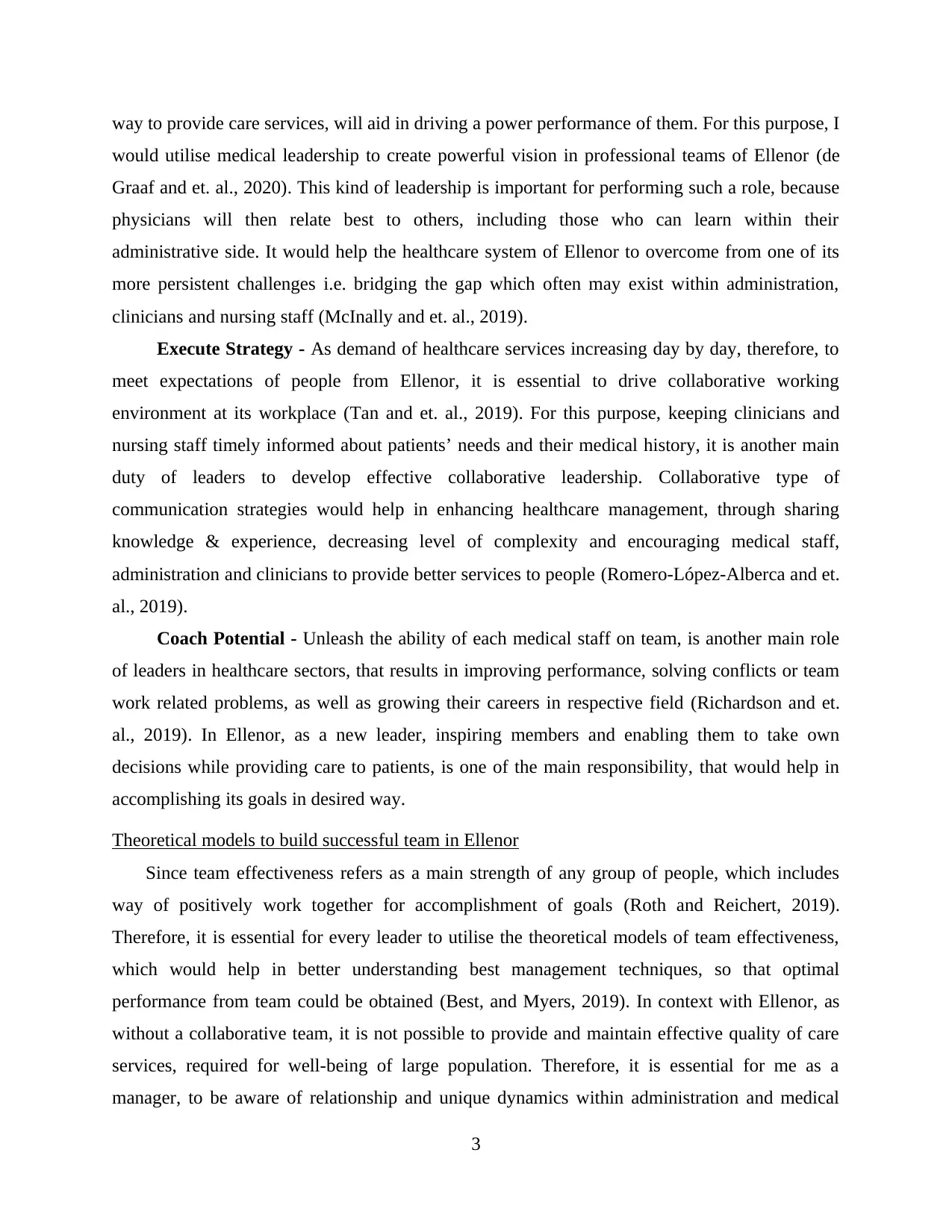
way to provide care services, will aid in driving a power performance of them. For this purpose, I
would utilise medical leadership to create powerful vision in professional teams of Ellenor (de
Graaf and et. al., 2020). This kind of leadership is important for performing such a role, because
physicians will then relate best to others, including those who can learn within their
administrative side. It would help the healthcare system of Ellenor to overcome from one of its
more persistent challenges i.e. bridging the gap which often may exist within administration,
clinicians and nursing staff (McInally and et. al., 2019).
Execute Strategy - As demand of healthcare services increasing day by day, therefore, to
meet expectations of people from Ellenor, it is essential to drive collaborative working
environment at its workplace (Tan and et. al., 2019). For this purpose, keeping clinicians and
nursing staff timely informed about patients’ needs and their medical history, it is another main
duty of leaders to develop effective collaborative leadership. Collaborative type of
communication strategies would help in enhancing healthcare management, through sharing
knowledge & experience, decreasing level of complexity and encouraging medical staff,
administration and clinicians to provide better services to people (Romero-López-Alberca and et.
al., 2019).
Coach Potential - Unleash the ability of each medical staff on team, is another main role
of leaders in healthcare sectors, that results in improving performance, solving conflicts or team
work related problems, as well as growing their careers in respective field (Richardson and et.
al., 2019). In Ellenor, as a new leader, inspiring members and enabling them to take own
decisions while providing care to patients, is one of the main responsibility, that would help in
accomplishing its goals in desired way.
Theoretical models to build successful team in Ellenor
Since team effectiveness refers as a main strength of any group of people, which includes
way of positively work together for accomplishment of goals (Roth and Reichert, 2019).
Therefore, it is essential for every leader to utilise the theoretical models of team effectiveness,
which would help in better understanding best management techniques, so that optimal
performance from team could be obtained (Best, and Myers, 2019). In context with Ellenor, as
without a collaborative team, it is not possible to provide and maintain effective quality of care
services, required for well-being of large population. Therefore, it is essential for me as a
manager, to be aware of relationship and unique dynamics within administration and medical
3
would utilise medical leadership to create powerful vision in professional teams of Ellenor (de
Graaf and et. al., 2020). This kind of leadership is important for performing such a role, because
physicians will then relate best to others, including those who can learn within their
administrative side. It would help the healthcare system of Ellenor to overcome from one of its
more persistent challenges i.e. bridging the gap which often may exist within administration,
clinicians and nursing staff (McInally and et. al., 2019).
Execute Strategy - As demand of healthcare services increasing day by day, therefore, to
meet expectations of people from Ellenor, it is essential to drive collaborative working
environment at its workplace (Tan and et. al., 2019). For this purpose, keeping clinicians and
nursing staff timely informed about patients’ needs and their medical history, it is another main
duty of leaders to develop effective collaborative leadership. Collaborative type of
communication strategies would help in enhancing healthcare management, through sharing
knowledge & experience, decreasing level of complexity and encouraging medical staff,
administration and clinicians to provide better services to people (Romero-López-Alberca and et.
al., 2019).
Coach Potential - Unleash the ability of each medical staff on team, is another main role
of leaders in healthcare sectors, that results in improving performance, solving conflicts or team
work related problems, as well as growing their careers in respective field (Richardson and et.
al., 2019). In Ellenor, as a new leader, inspiring members and enabling them to take own
decisions while providing care to patients, is one of the main responsibility, that would help in
accomplishing its goals in desired way.
Theoretical models to build successful team in Ellenor
Since team effectiveness refers as a main strength of any group of people, which includes
way of positively work together for accomplishment of goals (Roth and Reichert, 2019).
Therefore, it is essential for every leader to utilise the theoretical models of team effectiveness,
which would help in better understanding best management techniques, so that optimal
performance from team could be obtained (Best, and Myers, 2019). In context with Ellenor, as
without a collaborative team, it is not possible to provide and maintain effective quality of care
services, required for well-being of large population. Therefore, it is essential for me as a
manager, to be aware of relationship and unique dynamics within administration and medical
3
⊘ This is a preview!⊘
Do you want full access?
Subscribe today to unlock all pages.

Trusted by 1+ million students worldwide
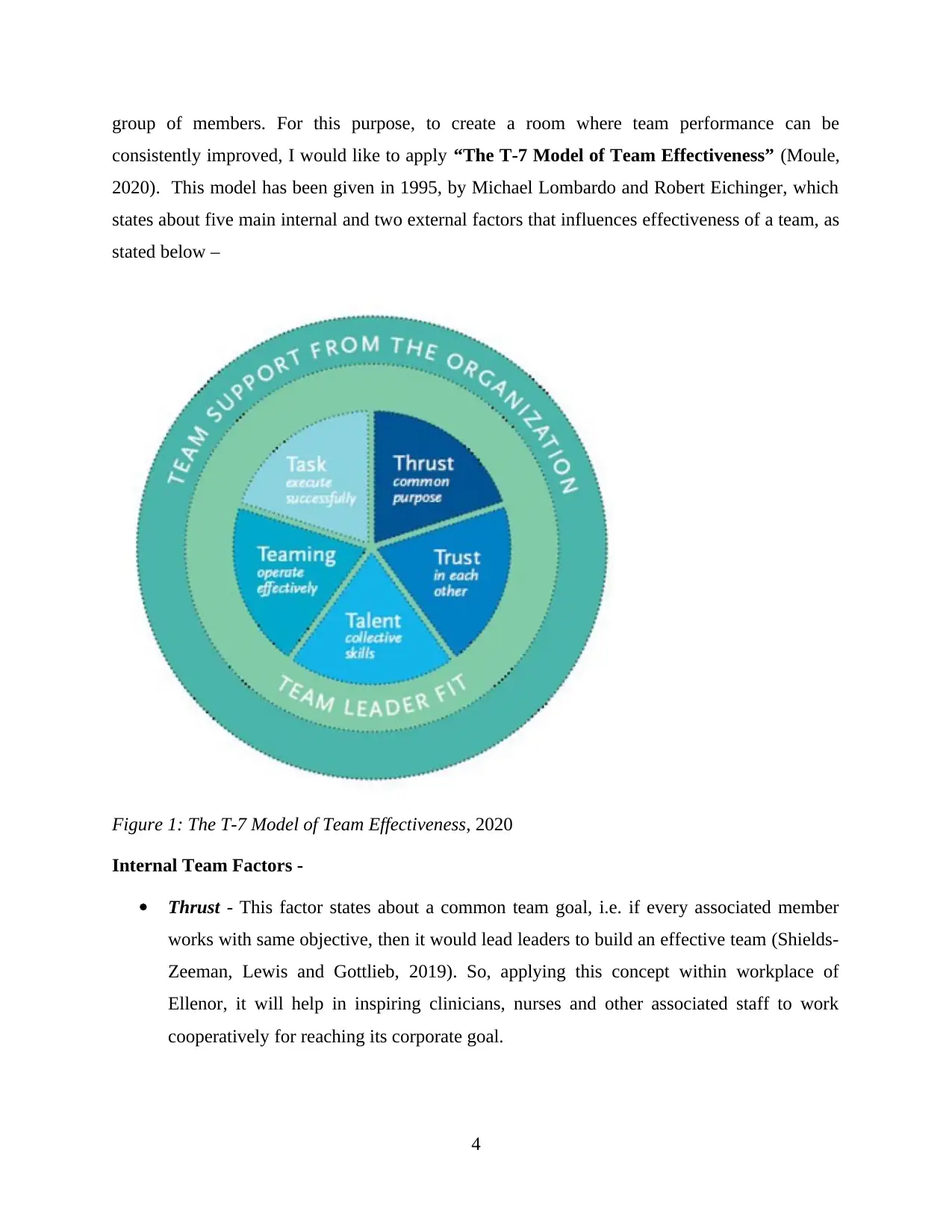
group of members. For this purpose, to create a room where team performance can be
consistently improved, I would like to apply “The T-7 Model of Team Effectiveness” (Moule,
2020). This model has been given in 1995, by Michael Lombardo and Robert Eichinger, which
states about five main internal and two external factors that influences effectiveness of a team, as
stated below –
Figure 1: The T-7 Model of Team Effectiveness, 2020
Internal Team Factors -
Thrust - This factor states about a common team goal, i.e. if every associated member
works with same objective, then it would lead leaders to build an effective team (Shields-
Zeeman, Lewis and Gottlieb, 2019). So, applying this concept within workplace of
Ellenor, it will help in inspiring clinicians, nurses and other associated staff to work
cooperatively for reaching its corporate goal.
4
consistently improved, I would like to apply “The T-7 Model of Team Effectiveness” (Moule,
2020). This model has been given in 1995, by Michael Lombardo and Robert Eichinger, which
states about five main internal and two external factors that influences effectiveness of a team, as
stated below –
Figure 1: The T-7 Model of Team Effectiveness, 2020
Internal Team Factors -
Thrust - This factor states about a common team goal, i.e. if every associated member
works with same objective, then it would lead leaders to build an effective team (Shields-
Zeeman, Lewis and Gottlieb, 2019). So, applying this concept within workplace of
Ellenor, it will help in inspiring clinicians, nurses and other associated staff to work
cooperatively for reaching its corporate goal.
4
Paraphrase This Document
Need a fresh take? Get an instant paraphrase of this document with our AI Paraphraser
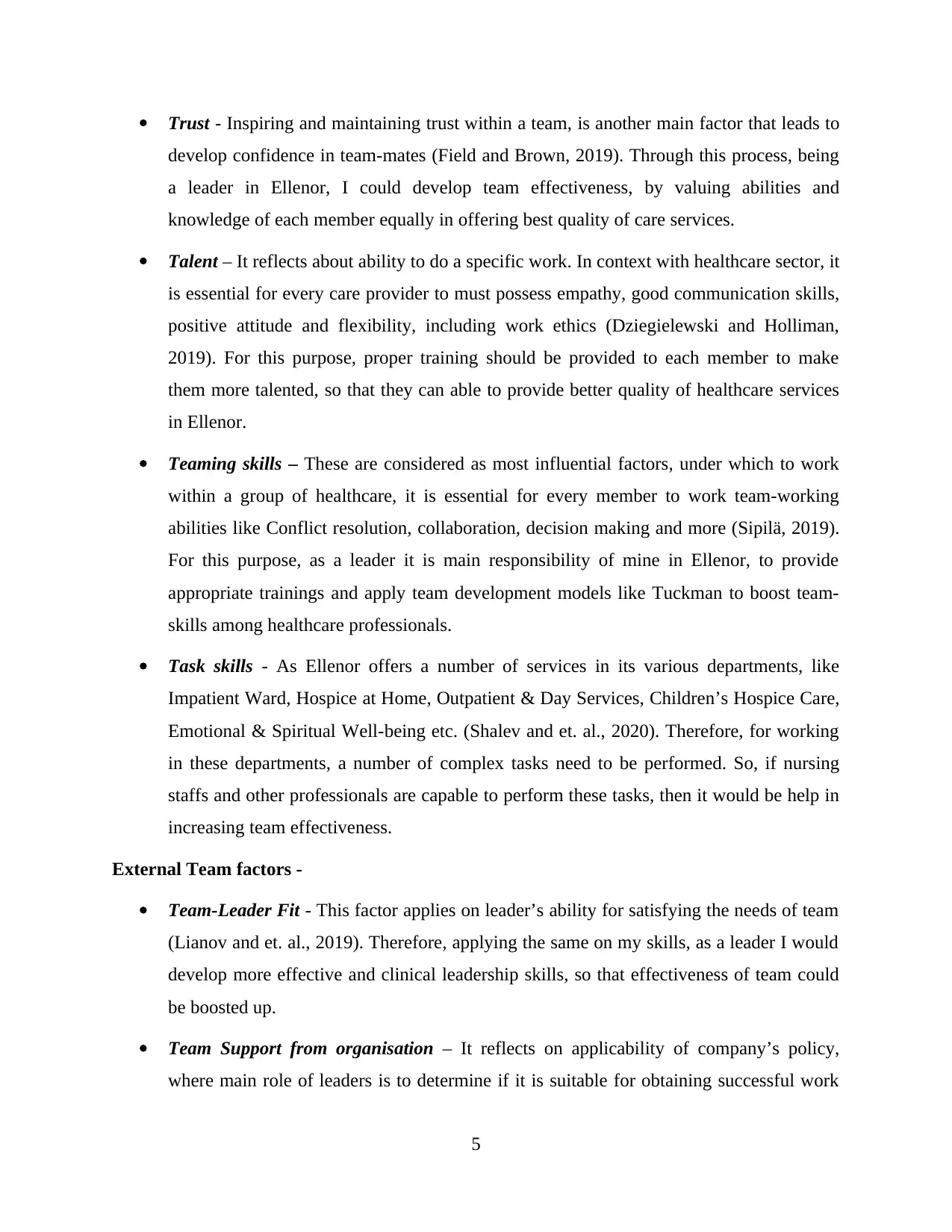
Trust - Inspiring and maintaining trust within a team, is another main factor that leads to
develop confidence in team-mates (Field and Brown, 2019). Through this process, being
a leader in Ellenor, I could develop team effectiveness, by valuing abilities and
knowledge of each member equally in offering best quality of care services.
Talent – It reflects about ability to do a specific work. In context with healthcare sector, it
is essential for every care provider to must possess empathy, good communication skills,
positive attitude and flexibility, including work ethics (Dziegielewski and Holliman,
2019). For this purpose, proper training should be provided to each member to make
them more talented, so that they can able to provide better quality of healthcare services
in Ellenor.
Teaming skills – These are considered as most influential factors, under which to work
within a group of healthcare, it is essential for every member to work team-working
abilities like Conflict resolution, collaboration, decision making and more (Sipilä, 2019).
For this purpose, as a leader it is main responsibility of mine in Ellenor, to provide
appropriate trainings and apply team development models like Tuckman to boost team-
skills among healthcare professionals.
Task skills - As Ellenor offers a number of services in its various departments, like
Impatient Ward, Hospice at Home, Outpatient & Day Services, Children’s Hospice Care,
Emotional & Spiritual Well-being etc. (Shalev and et. al., 2020). Therefore, for working
in these departments, a number of complex tasks need to be performed. So, if nursing
staffs and other professionals are capable to perform these tasks, then it would be help in
increasing team effectiveness.
External Team factors -
Team-Leader Fit - This factor applies on leader’s ability for satisfying the needs of team
(Lianov and et. al., 2019). Therefore, applying the same on my skills, as a leader I would
develop more effective and clinical leadership skills, so that effectiveness of team could
be boosted up.
Team Support from organisation – It reflects on applicability of company’s policy,
where main role of leaders is to determine if it is suitable for obtaining successful work
5
develop confidence in team-mates (Field and Brown, 2019). Through this process, being
a leader in Ellenor, I could develop team effectiveness, by valuing abilities and
knowledge of each member equally in offering best quality of care services.
Talent – It reflects about ability to do a specific work. In context with healthcare sector, it
is essential for every care provider to must possess empathy, good communication skills,
positive attitude and flexibility, including work ethics (Dziegielewski and Holliman,
2019). For this purpose, proper training should be provided to each member to make
them more talented, so that they can able to provide better quality of healthcare services
in Ellenor.
Teaming skills – These are considered as most influential factors, under which to work
within a group of healthcare, it is essential for every member to work team-working
abilities like Conflict resolution, collaboration, decision making and more (Sipilä, 2019).
For this purpose, as a leader it is main responsibility of mine in Ellenor, to provide
appropriate trainings and apply team development models like Tuckman to boost team-
skills among healthcare professionals.
Task skills - As Ellenor offers a number of services in its various departments, like
Impatient Ward, Hospice at Home, Outpatient & Day Services, Children’s Hospice Care,
Emotional & Spiritual Well-being etc. (Shalev and et. al., 2020). Therefore, for working
in these departments, a number of complex tasks need to be performed. So, if nursing
staffs and other professionals are capable to perform these tasks, then it would be help in
increasing team effectiveness.
External Team factors -
Team-Leader Fit - This factor applies on leader’s ability for satisfying the needs of team
(Lianov and et. al., 2019). Therefore, applying the same on my skills, as a leader I would
develop more effective and clinical leadership skills, so that effectiveness of team could
be boosted up.
Team Support from organisation – It reflects on applicability of company’s policy,
where main role of leaders is to determine if it is suitable for obtaining successful work
5
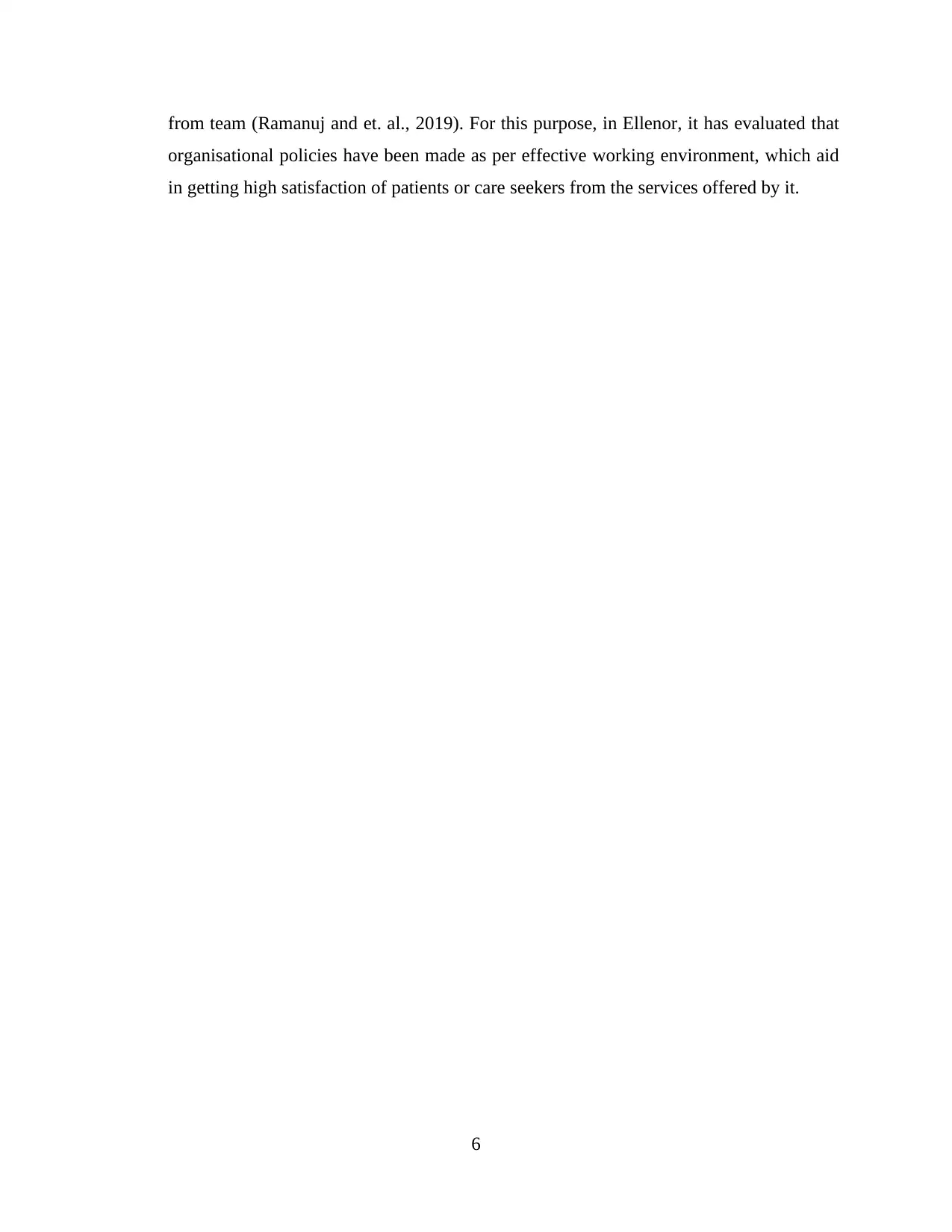
from team (Ramanuj and et. al., 2019). For this purpose, in Ellenor, it has evaluated that
organisational policies have been made as per effective working environment, which aid
in getting high satisfaction of patients or care seekers from the services offered by it.
6
organisational policies have been made as per effective working environment, which aid
in getting high satisfaction of patients or care seekers from the services offered by it.
6
⊘ This is a preview!⊘
Do you want full access?
Subscribe today to unlock all pages.

Trusted by 1+ million students worldwide
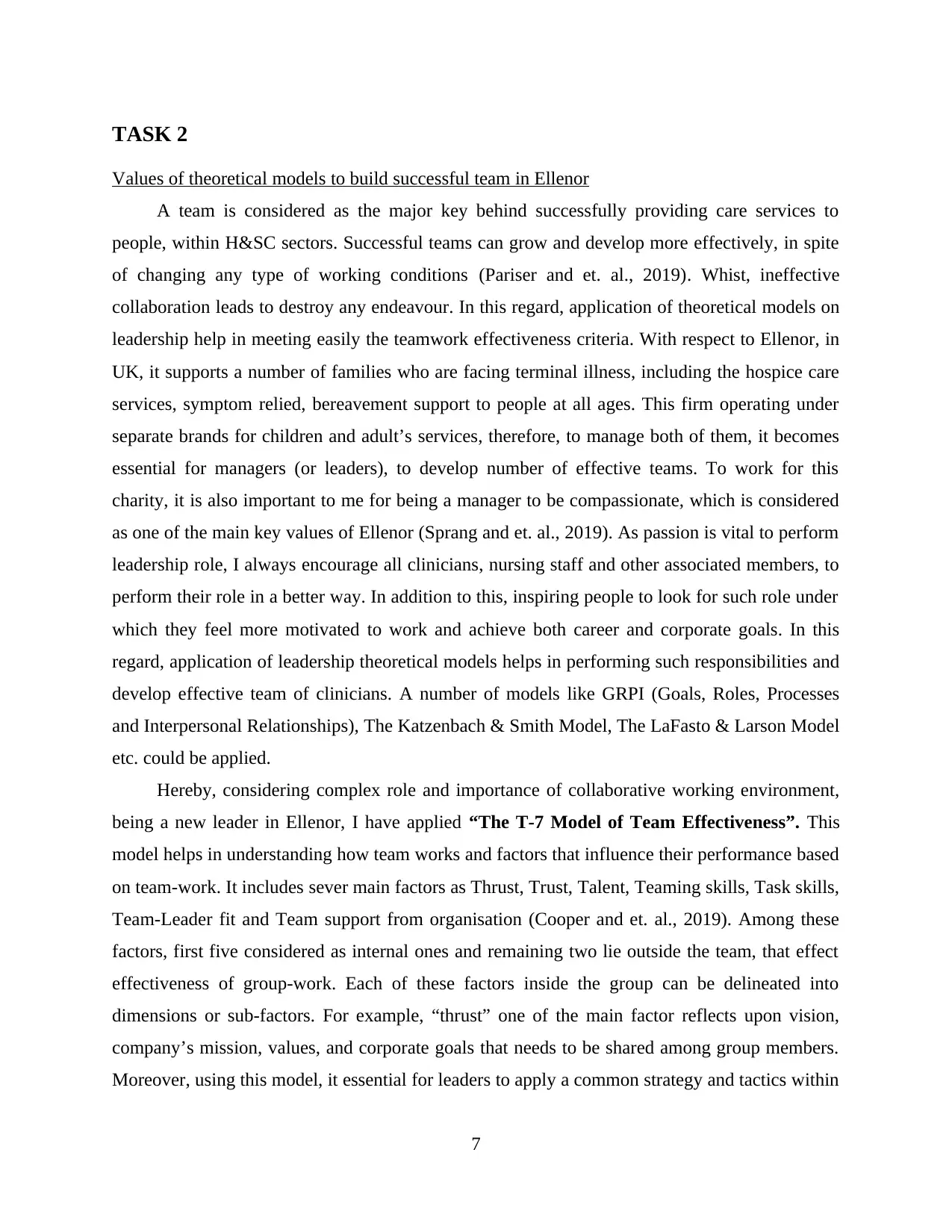
TASK 2
Values of theoretical models to build successful team in Ellenor
A team is considered as the major key behind successfully providing care services to
people, within H&SC sectors. Successful teams can grow and develop more effectively, in spite
of changing any type of working conditions (Pariser and et. al., 2019). Whist, ineffective
collaboration leads to destroy any endeavour. In this regard, application of theoretical models on
leadership help in meeting easily the teamwork effectiveness criteria. With respect to Ellenor, in
UK, it supports a number of families who are facing terminal illness, including the hospice care
services, symptom relied, bereavement support to people at all ages. This firm operating under
separate brands for children and adult’s services, therefore, to manage both of them, it becomes
essential for managers (or leaders), to develop number of effective teams. To work for this
charity, it is also important to me for being a manager to be compassionate, which is considered
as one of the main key values of Ellenor (Sprang and et. al., 2019). As passion is vital to perform
leadership role, I always encourage all clinicians, nursing staff and other associated members, to
perform their role in a better way. In addition to this, inspiring people to look for such role under
which they feel more motivated to work and achieve both career and corporate goals. In this
regard, application of leadership theoretical models helps in performing such responsibilities and
develop effective team of clinicians. A number of models like GRPI (Goals, Roles, Processes
and Interpersonal Relationships), The Katzenbach & Smith Model, The LaFasto & Larson Model
etc. could be applied.
Hereby, considering complex role and importance of collaborative working environment,
being a new leader in Ellenor, I have applied “The T-7 Model of Team Effectiveness”. This
model helps in understanding how team works and factors that influence their performance based
on team-work. It includes sever main factors as Thrust, Trust, Talent, Teaming skills, Task skills,
Team-Leader fit and Team support from organisation (Cooper and et. al., 2019). Among these
factors, first five considered as internal ones and remaining two lie outside the team, that effect
effectiveness of group-work. Each of these factors inside the group can be delineated into
dimensions or sub-factors. For example, “thrust” one of the main factor reflects upon vision,
company’s mission, values, and corporate goals that needs to be shared among group members.
Moreover, using this model, it essential for leaders to apply a common strategy and tactics within
7
Values of theoretical models to build successful team in Ellenor
A team is considered as the major key behind successfully providing care services to
people, within H&SC sectors. Successful teams can grow and develop more effectively, in spite
of changing any type of working conditions (Pariser and et. al., 2019). Whist, ineffective
collaboration leads to destroy any endeavour. In this regard, application of theoretical models on
leadership help in meeting easily the teamwork effectiveness criteria. With respect to Ellenor, in
UK, it supports a number of families who are facing terminal illness, including the hospice care
services, symptom relied, bereavement support to people at all ages. This firm operating under
separate brands for children and adult’s services, therefore, to manage both of them, it becomes
essential for managers (or leaders), to develop number of effective teams. To work for this
charity, it is also important to me for being a manager to be compassionate, which is considered
as one of the main key values of Ellenor (Sprang and et. al., 2019). As passion is vital to perform
leadership role, I always encourage all clinicians, nursing staff and other associated members, to
perform their role in a better way. In addition to this, inspiring people to look for such role under
which they feel more motivated to work and achieve both career and corporate goals. In this
regard, application of leadership theoretical models helps in performing such responsibilities and
develop effective team of clinicians. A number of models like GRPI (Goals, Roles, Processes
and Interpersonal Relationships), The Katzenbach & Smith Model, The LaFasto & Larson Model
etc. could be applied.
Hereby, considering complex role and importance of collaborative working environment,
being a new leader in Ellenor, I have applied “The T-7 Model of Team Effectiveness”. This
model helps in understanding how team works and factors that influence their performance based
on team-work. It includes sever main factors as Thrust, Trust, Talent, Teaming skills, Task skills,
Team-Leader fit and Team support from organisation (Cooper and et. al., 2019). Among these
factors, first five considered as internal ones and remaining two lie outside the team, that effect
effectiveness of group-work. Each of these factors inside the group can be delineated into
dimensions or sub-factors. For example, “thrust” one of the main factor reflects upon vision,
company’s mission, values, and corporate goals that needs to be shared among group members.
Moreover, using this model, it essential for leaders to apply a common strategy and tactics within
7
Paraphrase This Document
Need a fresh take? Get an instant paraphrase of this document with our AI Paraphraser
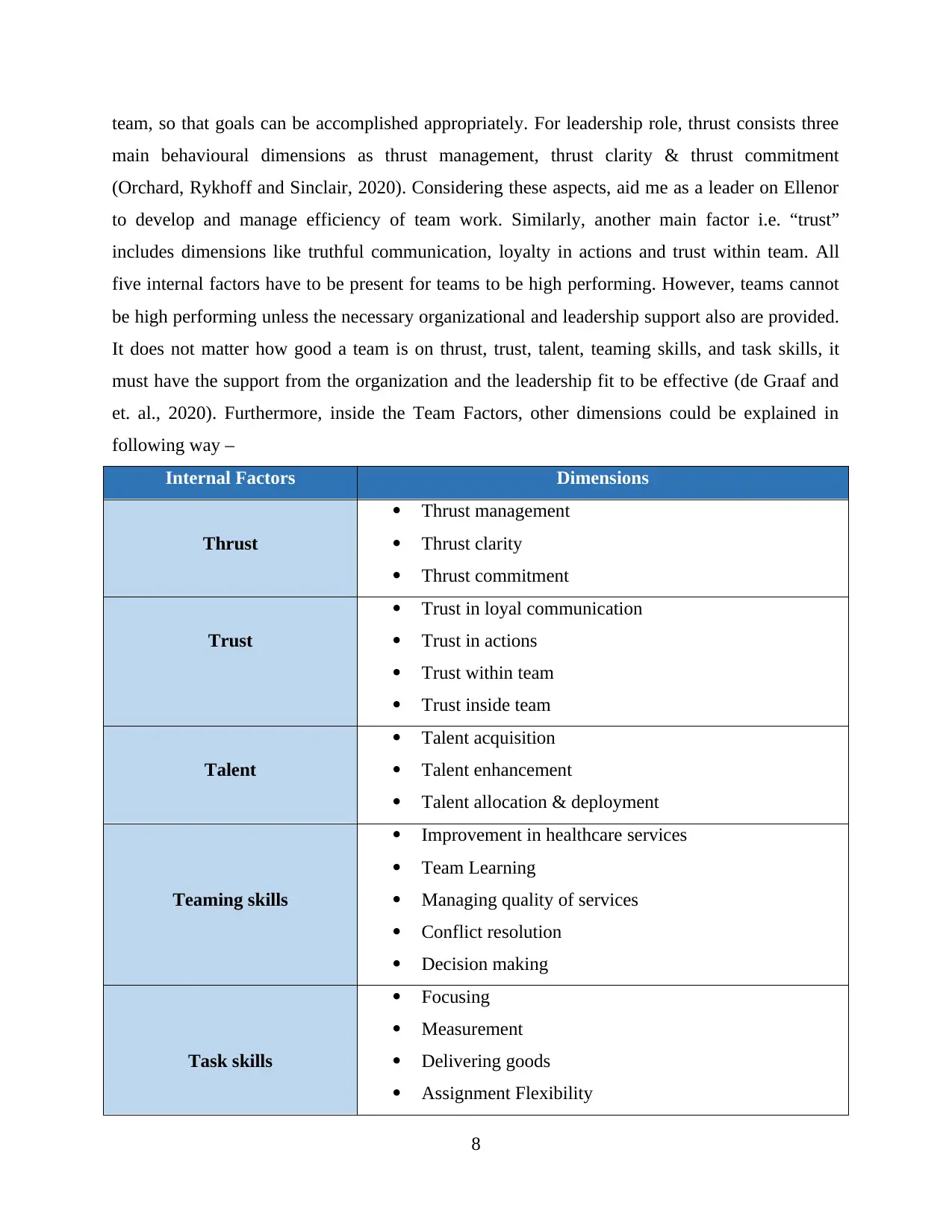
team, so that goals can be accomplished appropriately. For leadership role, thrust consists three
main behavioural dimensions as thrust management, thrust clarity & thrust commitment
(Orchard, Rykhoff and Sinclair, 2020). Considering these aspects, aid me as a leader on Ellenor
to develop and manage efficiency of team work. Similarly, another main factor i.e. “trust”
includes dimensions like truthful communication, loyalty in actions and trust within team. All
five internal factors have to be present for teams to be high performing. However, teams cannot
be high performing unless the necessary organizational and leadership support also are provided.
It does not matter how good a team is on thrust, trust, talent, teaming skills, and task skills, it
must have the support from the organization and the leadership fit to be effective (de Graaf and
et. al., 2020). Furthermore, inside the Team Factors, other dimensions could be explained in
following way –
Internal Factors Dimensions
Thrust
Thrust management
Thrust clarity
Thrust commitment
Trust
Trust in loyal communication
Trust in actions
Trust within team
Trust inside team
Talent
Talent acquisition
Talent enhancement
Talent allocation & deployment
Teaming skills
Improvement in healthcare services
Team Learning
Managing quality of services
Conflict resolution
Decision making
Task skills
Focusing
Measurement
Delivering goods
Assignment Flexibility
8
main behavioural dimensions as thrust management, thrust clarity & thrust commitment
(Orchard, Rykhoff and Sinclair, 2020). Considering these aspects, aid me as a leader on Ellenor
to develop and manage efficiency of team work. Similarly, another main factor i.e. “trust”
includes dimensions like truthful communication, loyalty in actions and trust within team. All
five internal factors have to be present for teams to be high performing. However, teams cannot
be high performing unless the necessary organizational and leadership support also are provided.
It does not matter how good a team is on thrust, trust, talent, teaming skills, and task skills, it
must have the support from the organization and the leadership fit to be effective (de Graaf and
et. al., 2020). Furthermore, inside the Team Factors, other dimensions could be explained in
following way –
Internal Factors Dimensions
Thrust
Thrust management
Thrust clarity
Thrust commitment
Trust
Trust in loyal communication
Trust in actions
Trust within team
Trust inside team
Talent
Talent acquisition
Talent enhancement
Talent allocation & deployment
Teaming skills
Improvement in healthcare services
Team Learning
Managing quality of services
Conflict resolution
Decision making
Task skills
Focusing
Measurement
Delivering goods
Assignment Flexibility
8
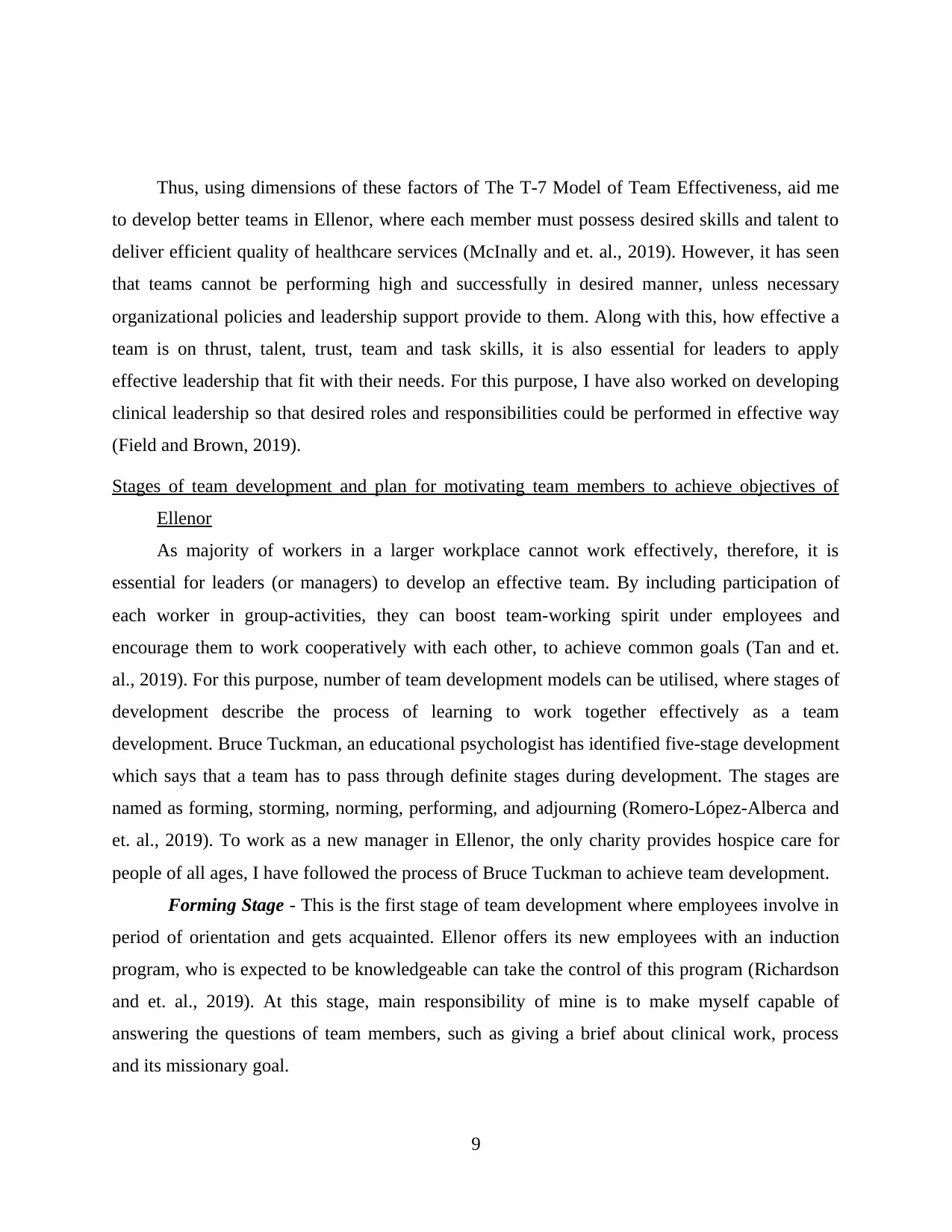
Thus, using dimensions of these factors of The T-7 Model of Team Effectiveness, aid me
to develop better teams in Ellenor, where each member must possess desired skills and talent to
deliver efficient quality of healthcare services (McInally and et. al., 2019). However, it has seen
that teams cannot be performing high and successfully in desired manner, unless necessary
organizational policies and leadership support provide to them. Along with this, how effective a
team is on thrust, talent, trust, team and task skills, it is also essential for leaders to apply
effective leadership that fit with their needs. For this purpose, I have also worked on developing
clinical leadership so that desired roles and responsibilities could be performed in effective way
(Field and Brown, 2019).
Stages of team development and plan for motivating team members to achieve objectives of
Ellenor
As majority of workers in a larger workplace cannot work effectively, therefore, it is
essential for leaders (or managers) to develop an effective team. By including participation of
each worker in group-activities, they can boost team-working spirit under employees and
encourage them to work cooperatively with each other, to achieve common goals (Tan and et.
al., 2019). For this purpose, number of team development models can be utilised, where stages of
development describe the process of learning to work together effectively as a team
development. Bruce Tuckman, an educational psychologist has identified five-stage development
which says that a team has to pass through definite stages during development. The stages are
named as forming, storming, norming, performing, and adjourning (Romero-López-Alberca and
et. al., 2019). To work as a new manager in Ellenor, the only charity provides hospice care for
people of all ages, I have followed the process of Bruce Tuckman to achieve team development.
Forming Stage - This is the first stage of team development where employees involve in
period of orientation and gets acquainted. Ellenor offers its new employees with an induction
program, who is expected to be knowledgeable can take the control of this program (Richardson
and et. al., 2019). At this stage, main responsibility of mine is to make myself capable of
answering the questions of team members, such as giving a brief about clinical work, process
and its missionary goal.
9
to develop better teams in Ellenor, where each member must possess desired skills and talent to
deliver efficient quality of healthcare services (McInally and et. al., 2019). However, it has seen
that teams cannot be performing high and successfully in desired manner, unless necessary
organizational policies and leadership support provide to them. Along with this, how effective a
team is on thrust, talent, trust, team and task skills, it is also essential for leaders to apply
effective leadership that fit with their needs. For this purpose, I have also worked on developing
clinical leadership so that desired roles and responsibilities could be performed in effective way
(Field and Brown, 2019).
Stages of team development and plan for motivating team members to achieve objectives of
Ellenor
As majority of workers in a larger workplace cannot work effectively, therefore, it is
essential for leaders (or managers) to develop an effective team. By including participation of
each worker in group-activities, they can boost team-working spirit under employees and
encourage them to work cooperatively with each other, to achieve common goals (Tan and et.
al., 2019). For this purpose, number of team development models can be utilised, where stages of
development describe the process of learning to work together effectively as a team
development. Bruce Tuckman, an educational psychologist has identified five-stage development
which says that a team has to pass through definite stages during development. The stages are
named as forming, storming, norming, performing, and adjourning (Romero-López-Alberca and
et. al., 2019). To work as a new manager in Ellenor, the only charity provides hospice care for
people of all ages, I have followed the process of Bruce Tuckman to achieve team development.
Forming Stage - This is the first stage of team development where employees involve in
period of orientation and gets acquainted. Ellenor offers its new employees with an induction
program, who is expected to be knowledgeable can take the control of this program (Richardson
and et. al., 2019). At this stage, main responsibility of mine is to make myself capable of
answering the questions of team members, such as giving a brief about clinical work, process
and its missionary goal.
9
⊘ This is a preview!⊘
Do you want full access?
Subscribe today to unlock all pages.

Trusted by 1+ million students worldwide
1 out of 17
Related Documents
Your All-in-One AI-Powered Toolkit for Academic Success.
+13062052269
info@desklib.com
Available 24*7 on WhatsApp / Email
![[object Object]](/_next/static/media/star-bottom.7253800d.svg)
Unlock your academic potential
Copyright © 2020–2025 A2Z Services. All Rights Reserved. Developed and managed by ZUCOL.



